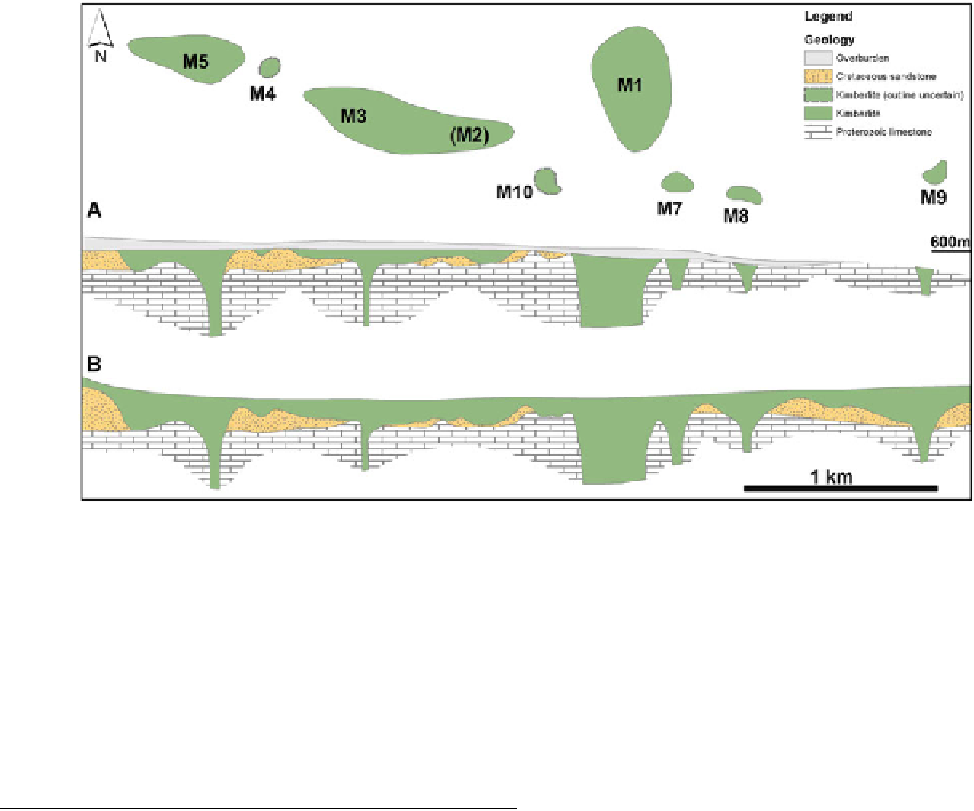Geology Reference
In-Depth Information
Fig. 17.7
Linear relation between the pipes of the Northern Group (pipe M6 to the west is not shown), after Fieremans and Fieremans (
1993
). A:
longitudinal profile; B: theoretical reconstruction of the profile before erosion to actual level
Detrital deposits inclusive of sandy argillaceous deposits
with kaolin nodules that overlie the kimberlite pipes run at
very high grades as do some of the hill-slope gravels. These
pediments or flash flood gravels were deposited onto pre-
existing limestone karst topography and are poorly sorted.
Further interpretation is complicated by excessive over-
burden (up to 40 m). However, pre-deposition karst features
and potholes have proven to be excellent diamond trap-sites
(reported grades of 100 cts/m
3
) while post-deposition sink-
hole developments exhibit limited diamond potential. Allu-
vial deposits inclusive of high and low terrace and valley
floor deposits occur along the Mbujimayi, Sankuru and Lubi
Rivers (and associated tributaries), and riverbed gravel
deposits, particularly in the Mbujimayi and Sankuru Rivers.
MIBA mining operations are becoming increasingly
marginal as most of the high grade detrital and river bed
deposits have been mined to exhaustion and because of
declining diamond prices, labour disputes, and power supply
problems. Production from the Mbuji Mayi kimberlites
ceased in November 2008 and the mine requires significant
recapitalisation if mining is to resume.
Table 17.1
Size, grade and revenue data for four of the Mbuji Mayi
kimberlites
Surface
area (ha)
Grade
(cts/m
3
)
Revenue
(US$/ct)
Kimberlite
Dimension
Massif-1
750
450 m
22.6
2.78
12-14
Massif-4
75
75 m
0.8
2.57
Massif-5
650
200 m
10.2
2.77
Massif-6
280
160 m
4.4
2.42
ct
carat;
ha
hectare
with Massif-4 have been mined to approximately 60 m
below surface while operations have advanced to below
50 m on Massif-5 (Fig.
17.6a
). Mining operations are
planned on Massif-1 using conventional drill and blast
methods although no plant processing capability exists.
Kimberlite grades are variable from 0.5 cts/m
3
in the
kimberlite, to 1.5 cts/m
3
in tuffaceous kimberlite
breccias, to 2-3 cts/m
3
in massive pyroclastic kimberlite. The
stone value is generally low, averaging at 12 to 14 US$/ct.
The inferred emplacement age of the kimberlites is
estimated at ca. 70 Ma (Davis
1977
; Sh¨rer et al.
1997
),
which is consistent with the mean age of a young concordant
zircon population recovered from an Upper Cretaceous
sandstone of 79
“
epiclastic
”
7 Ma (Roberts et al.
2014
).
40
Ar/
39
Ar
dating on diamond inclusions reached consistently older
ages for kimberlite emplacement (Phillips et al.
2004
)
between 115
2 Ma and 801
13 Ma, which can be
explained in terms of partial retention of inherited argon,
produced between the times of diamond crystallization and
kimberlite eruption.
17.4.2 Tshibwe Kimberlite Cluster
In 1956 a new kimberlite was intersected in extensive eluvial
workings in the Katsha-Kabonji-Tshibua area, and is now
known as the Tshibwe kimberlite pipe (Figs.
17.5
and
17.8
).
Following the discovery, a drilling program by MIBA led to
the discovery of a further five kimberlites in the area, which







Search WWH ::

Custom Search